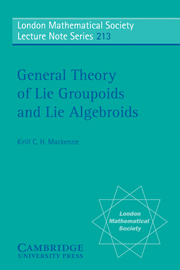Book contents
- Frontmatter
- Contents
- Prologue
- Introduction
- Preface
- TERMINOLOGY AND NOTATION
- ACKNOWLEDGEMENTS
- PART ONE THE GENERAL THEORY
- PART TWO THE TRANSITIVE THEORY
- 5 Infinitesimal Connection Theory
- 6 Path Connections and Lie Theory
- 7 Cohomology and Schouten Calculus
- 8 The Cohomological Obstruction
- PART THREE THE POISSON AND SYMPLECTIC THEORIES
- Appendix
- Bibliography
- Index
5 - Infinitesimal Connection Theory
from PART TWO - THE TRANSITIVE THEORY
Published online by Cambridge University Press: 05 April 2013
- Frontmatter
- Contents
- Prologue
- Introduction
- Preface
- TERMINOLOGY AND NOTATION
- ACKNOWLEDGEMENTS
- PART ONE THE GENERAL THEORY
- PART TWO THE TRANSITIVE THEORY
- 5 Infinitesimal Connection Theory
- 6 Path Connections and Lie Theory
- 7 Cohomology and Schouten Calculus
- 8 The Cohomological Obstruction
- PART THREE THE POISSON AND SYMPLECTIC THEORIES
- Appendix
- Bibliography
- Index
Summary
Connection theory is inextricably bound up with the theory of transitive Lie algebroids. Accounts of the general theory of connections (that is to say, not merely the case of connections in vector bundles) are traditionally presented in terms of principal bundles, and can equally well be presented in terms of locally trivial Lie groupoids. (Indeed the Lie groupoid formulation is often clearer since there is no need to choose arbitrary reference points, and holonomy groups, for example, are consequently well defined at each point, rather than only up to conjugacy.) However a very great deal of general connection theory — that part which we call the infinitesimal theory — naturally resides within the context of abstract transitive Lie algebroids. It both clarifies the exposition and strengthens the results to maintain a separation between those parts of the theory which require principal bundles (or Lie groupoids) and those which do not.
On the other hand, there is a large family of results for transitive Lie algebroids which are most naturally proved by using connection theory. These are dealt with in §6.5.
This chapter and the following one are self–contained but make no attempt to motivate the notion of connection or describe any of its many applications. A reader who has never met the notion of connection before will need to supplement these chapters with other accounts. Some suggestions are included in the Notes to this chapter.
- Type
- Chapter
- Information
- General Theory of Lie Groupoids and Lie Algebroids , pp. 181 - 211Publisher: Cambridge University PressPrint publication year: 2005



